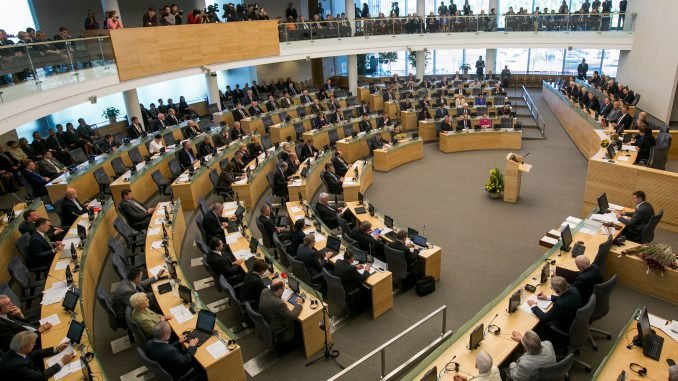
June has completely shuffled around the usual picture on the Lithuanian party popularity table – after a long pause, the Lithuanian Social Democratic Party (LSDP) has taken second place, leaving the Homeland Union – Lithuanian Christian Democrats (TS-LKD) behind itself, a survey performed by the company Vilmorus indicates, Indrė Naureckaitė writes in lrytas.lt.
While President Gitanas Nausėda continues to build support for himself, Prime Minister Ingrida Šimonytė’s evaluation is negative for the first time ever.
Unprecedented changes
As per the data of a survey performed on June 9-18 on commission from Lietuvos Rytas, if the elections were held next Sunday, the opposition Lithuanian Farmer and Greens Union (LVŽS) would come out victorious, maintaining first place in the party rating list for two months in a row now.
In May, the party would have received 16.2% of the vote, in June – 15.1%.
Vilmorus head, sociologist Vladas Gaidys, notes that the “Farmers’” ratings didn’t change over a month. “They have their electorate, which supports them out of inertia, given no events,” he said.
Meanwhile, the support for the Homeland Union – Lithuanian Christian Democrats (TS-LKD) continues to decline – in June, the party fell from second to third place in popularity. Support for the party fell by 3% over the month, from 14.8% in May to 11.8% in June.

“The biggest change is the Homeland Union landing in third place. I don’t ever recall such a result in surveys before. They have been in second, but third – I simply cannot recall it,” V. Gaidys spoke.
Support for the LSDP continues to rise – in June, the LSDP jumped from third to second place in the ratings. The month saw the party gain 3.1% support, going from 10.2% in May to 13.3% in June.
“Growth in support can be seen, it’s a trend. They have doubled [their ratings] since April. I would link it to Vilija Blinkevičiūtė, I see no other events related to the party,” the sociologist says.
The Liberal Movement maintains stable support – in May, the party had 6.2% support, going to 6% in June. While they are a ruling coalition party, they maintain stable support.
“The Liberals’ electorate was previously younger based on its structure, but now it ranges between 30-40 years old. Holding a higher education, having higher incomes and living in Vilnius,” V. Gaidys listed.
The Labour Party remains fifth on the table with minor shifts in support, going from 4.4% in May to 5.2% in June.
“The Labour Party remains mostly stable. It would get votes from ethnic minorities, the unemployed, pre-pension age voters who could lose their jobs,” the sociologist said.
Next in the table, we find the Freedom Party, which would have received 3.5% of the vote in May versus 2.9% in June.
“The Freedom Party would receive support from 2.9% of all respondents and 5% if it’s only that intent on voting and so, the party remains at around the threshold. Something of a declining trend can be seen – it is, after all, a ruling party. Based on our data, the party has the support of youths, particularly students,” V. Gaidys spoke.
The Lithuanian Social Democratic Labour Party (LSDDP) elected a new leader and in May, it would have received 3.1% of the vote, going down to 2% in June.
The Electoral Action of Poles in Lithuania – Christian Families Union (LLRA-KŠS) remains in the last place on the table with 0.8% support in June, down from 1.3% in May.
What led to the changes?
In regard to the changes in party support, V. Gaidys mused that the Conservatives’ ratings might have declined due to three factors.
“Firstly – the TS-LKD is a ruling party. It almost never is the case that a ruling party’s ratings would rise. It’s a universal occurrence.
Secondly – fairly intensive debates on Western values, partnership. It is evident that the party lacks unity within, it’s visible there’s also no unity among the electorate on this matter.
Thirdly – the confrontation with the president, sometimes over incomprehensible matters, representation. Considering that the president is elected directly in Lithuania, he has certain traits that make him appealing to most – presidents always have high ratings in Lithuania,” V. Gaidys spoke of the Conservatives’ decline.
According to V. Gaidys, the Conservatives had such low ratings back in 2016 – early 2017. However, while in the opposition afterwards, they quite quickly rebuilt their popularity.
Meanwhile, in terms of the currently most favourably perceived and stably maintaining its rating LVŽS, the sociologist said that such a response to the “Farmers” is out of momentum.
“It’s not a “deep” rating. The “Farmer” party displays organisational crises and the party’s leader has fairly poor ratings. I think that these ratings could decline easily – it will essentially depend on the Social Democratic Party. V. Blinkevičiūtė boosted their ratings quite significantly, but if the party were to get something more done with its structure, it could grow further,” the sociologist mused.
According to him, the Social Democrats’ ratings still have room to grow – the party could siphon away the electorates of the “Farmers”, the Labour Party and the Social Democratic Labour Party. V. Gaidys points out that the Social Democrats last had similar ratings back in April 2018.
Most favourably received politicians
For the first time since the ratings started, Ingrida Šimonytė has a net negative evaluation. In June, the number of respondents viewing her negatively was larger than those viewing her positively, respectively 41.6% and 39.8% of respondents.
However, V. Gaidys downplays this result.
“I. Šimonytė has been on the ratings since 2009 when she was a minister, but she had net positive ratings even during the deepest moments of the crisis when the Conservatives were the ruling party. It was a truly difficult time, but she was perceived positively,” V. Gaidys reminded.
According to him, while a net negative has been recorded for I. Šimonytė for the first time, the prime minister’s ratings remain fundamentally stable, only shifting within the error margin despite the TS-LKD’s ratings demonstrating a trend of decline. V. Gaidys believes that the problem is related to I. Šimonytė‘s cabinet.
“Of the 14 ministers, only two have net positive evaluations, most are little known figures, the public does not have an opinion on them. There are problems there, the cabinet’s ratings are also net negative, but I. Šimonytė herself is strong with 40% viewing her positively,” the sociologist spoke.
Net positive evaluations were demonstrated by Minister of National Defence Arvydas Anušauskas (30% positive evaluations, 25.2% negative and 44.8% no opinion) and Minister of Interior Affairs Agnė Bilotaitė (33.4% positive evaluations, 32.8% negative and 33.8% no opinion).
V. Gaidys highlights that in the open question of “What Lithuanian public figures represent your interests best?” sees I. Šimonytė land second after President Gitanas Nausėda.
President Nausėda remains the most favourably viewed politician in Lithuania. In May, G. Nausėda had the support of 61.4% of respondents, in June – 63.1%.
“It is important that he is viewed positively by all age groups, including the Conservatives’ electorate,” V. Gaidys stated.
However, the president is still rebuilding his lost support because prior to the coronavirus crisis, G. Nausėda had positive evaluations from 82% of respondents.
“G. Nausėda faced a great downswing, big misfortune due to the quarantine, which left him as the president invisible – not travelling, not meeting, which would have been the norm, expected of the president. He was essentially non-present for a year. He tried to campaign for vaccination, but it wasn’t what’s needed from our president. But now, for two or three months, we see presidential functions,” the sociologist spoke.
Having surged to second place among the most popular politicians in the country last month, Social Democrat leader V. Blinkevičiūtė maintains this position in June as well, going from 49.7% support in May to 49% in June.
“The previous survey was being performed when she was elected party chairwoman, she was constantly visible. A month has passed and the ratings remain the same, which means she has potential.
However, unlike G. Nausėda, her ratings aren’t presidential – there are groups of citizens who view her negatively. Youths do, the Homeland Union and Freedom Party electorates view her negatively. Positive evaluations are predominantly from among those in regional centres, rural areas, the elderly, pensioners, women, individuals who need more social support,” he observed.
V. Gaidys also points to the particularly high ratings held by Kaunas city Mayor Visvaldas Matijošaitis, which are at 43% support. According to him, the mayor’s ratings have been growing lately, with the current evaluation being the highest since last year. “His ratings are at 71% in Kaunas – he’s received more favourably there than G. Nausėda is across Lithuania. V. Matijošaitis is viewed negatively by Vilnius, as well as Homeland Union voters,” V. Gaidys stated.


Be the first to comment